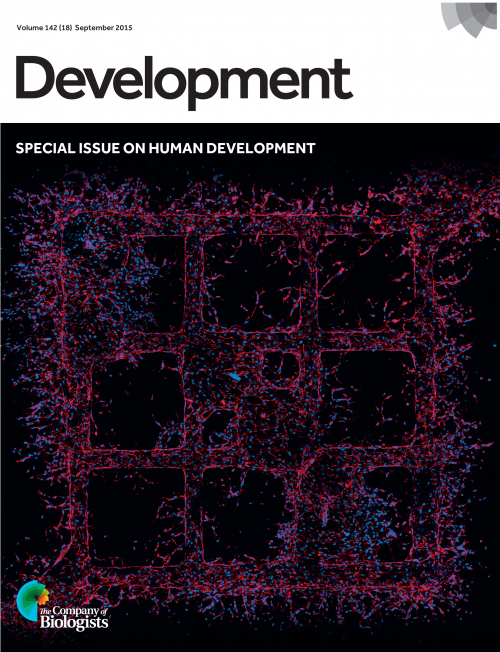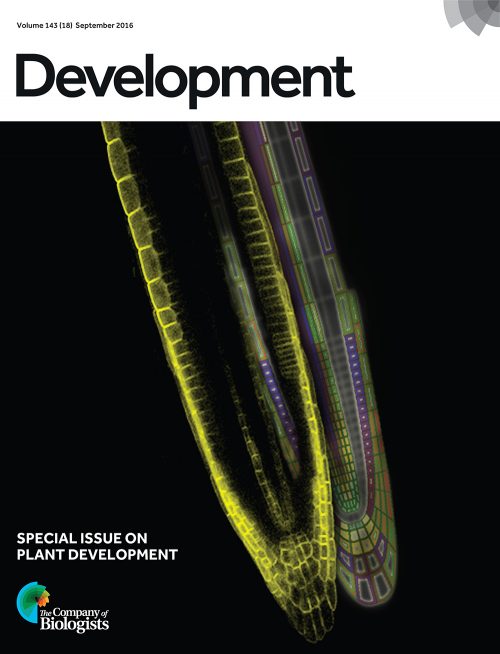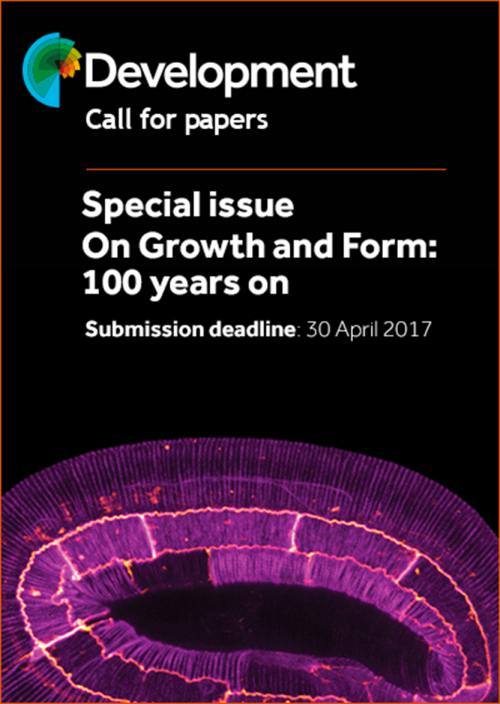The times they are a-changin’
Posted by the Node, on 3 January 2017
This Editorial originally appeared in Development, Volume 144, Issue 1
Olivier Pourquie
The past 15 years have witnessed major evolutions in the field of developmental biology – in imaging technology, genome editing, development of new ‘model’ systems and many other areas. Much of the action in our domain is now taking place in the stem cell field. Since I took over as Editor in Chief of Development, I have encouraged submission and publication of the best possible stem cell papers in the journal. We created a dedicated ‘Stem Cells and Regeneration’ section and have tried to promote the area in our front section (review-type content) with the recruitment of Caroline Hendry, our Reviews Editor dedicated to the stem cell field. More recently, we have extended this initiative to try to capture papers relating to human developmental biology, a field that has grown beyond its descriptive anatomical roots largely thanks to the development of stem cell-based technologies such as organoids; from 2017 onwards, these papers will also be collected together in a special ‘Human Development’ section of the journal. To demonstrate our commitment in these fields, we have published special issues on stem cells and regeneration in 2013 (http://dev.biologists.org/content/140/12) and on human development in 2015 (http://dev.biologists.org/content/142/18), which proved to be great successes.

We have also built a team of editors that include world leaders in stem cell biology. To further promote Development in this area, we recruited Melissa Little, who pioneered kidney organoids, to act as a guest editor for one year (2016), focusing on putting together a Special Issue on organoids to be published in early 2017. Finally, in 2014 and 2016, we organized very successful dedicated meetings on the theme ‘From Stem Cells to Human Development’. The 2016 meeting showcased the newest developments in the field of human developmental biology, including progress in emerging technologies such as organoids, bioengineering and single cell analyses (Craft and Johnson, 2017). We hope to continue this series of meetings in 2018, so look out for further announcements.
This editorial strategy – to promote the stem cell field – was initiated in 2010 and it is now time to look back and examine whether our efforts have been successful. But how do we measure success? Like large sectors of the community, I and Development’s editors feel that inappropriate prominence has been given to the Impact Factor (IF) (Pourquié, 2013). Development’s IF is essentially stable, and the journal performs well in other metrics, particularly the cited half-life, reflecting the longevity of our papers (see http://dev.biologists.org/content/about#metrics). Looking at a more granular level, the Stem Cells and Regeneration section of the journal (which now represents roughly one quarter of the research papers published) outperforms other research content in terms of citation levels, as do Techniques and Resources papers. Looking at other measures of journal performance, download and altmetrics data also speak to the success of our stem cell strategy, with stem cell papers typically among the most accessed research content each year. Along with the support we have received from the community (Pourquié and Brown, 2016a), these metrics give us confidence that our strategic focus on the stem cell field has been justified.
However, this is not to say that we have forgotten other aspects of developmental biology, or that we do not see and value the significant advances being made in many areas of the field. The plant field continues to fare very well in the journal – plant papers rank alongside animal stem cell papers in terms of citation rates – and we recently published a Special Issue dedicated to plant development (http://dev.biologists.org/content/143/18) in honour of the pioneering plant developmental biologist Ian Sussex.

Looking forwards, we see a growth in the areas of biophysical, mechanical, quantitative and computational developmental biology. 2017 sees the 100 year anniversary of the publication of D’Arcy Thompson’s landmark book On Growth and Form (Thompson, 1917) and we are planning to mark this occasion with a Special Issue of the journal entitled ‘On Growth and Form – 100 years on’ – which will celebrate the advances we have made in the past century, and look forwards to the future challenges of the field. We’re delighted to announce that this issue will be guest edited by L. Mahadevan (Harvard University), working alongside our longstanding editor Thomas Lecuit (see http://dev.biologists.org/content/special-issue-growth-and-form for more information). More generally, we hope that Development’s pages reflect the broad (and growing) scope of our field, and showcase some of the most exciting advances being made in labs across the world.

To continue to attract such papers, we need to respond to community concerns around the publishing process. To this end, we have recently introduced several important changes to the reviewing process. We now provide more explicit reviewing guidelines and forms, aiming to streamline the reviewing process as much as possible. Importantly, we have now introduced cross-referee commenting in the review process (Pourquie and Brown, 2016b). This means that once the reviews are completed, the reviewers are able to see each other’s reviews and have a 48 h window in which to provide extra feedback to help the editor make a decision. Although it is still early days for this new system, we feel it will help generate more consensual reviews and shorten the time to process papers. In addition, we are looking at ways of making it easier for authors to submit their work to Development. We recognise that you have a wide choice of journals to which you can submit, and we hope to minimise the effort required to send your paper to us. Although our Guide to Authors details specific formatting guidelines, we aim to be as flexible as possible in terms of article format at initial submission, and are working on streamlining this process further; we welcome your feedback on what changes we could make to improve the author experience.
Finally, preprints are also becoming a hot topic in life-science publishing, and Development has adopted a preprint-friendly policy. Preprints are manuscripts that are deposited in a public repository such as bioRxiv (http://biorxiv.org/) prior to publication. These manuscripts, which usually have not yet been peer-reviewed, are freely accessible to the entire scientific community. In 2015, we made it possible for authors submitting to Development to have their paper automatically deposited in bioRxiv, making it public in a matter of days. Now, you can also submit to Development through the bioRxiv submission system. This preprint model has been in place for more than 20 years in the maths and physics communities and it offers many advantages. Most importantly, research results are not held up from the scientific community for months or years due to the ever-increasing length of the review process. Thus, the data are immediately available and not hidden behind a paywall. This also offers the scientific community an opportunity to comment and help the authors consolidate the work prior to formal journal publication. In the past year or so, the number of preprints submitted to bioRxiv and other preprint servers has exploded and this trend is unlikely to slow down. The Node now posts a monthly list of new developmental biology-related preprints, making it easier for you to find the latest research in your field. Preprints have a digital object identifier (DOI) and are thus citable, and there is increasing support for allowing (and encouraging) preprints to be listed and considered in evaluation of grants and CVs. Although there is currently no direct conflict between preprint servers and traditional journals, the increasing use of preprint repositories will clearly impact the publishing world and as a community we need to start thinking about the future of scientific publications. Through what feels like a period of change, Development will strive to make publishing a less painful process for authors, and a richer experience for readers. Although Bob Dylan clearly wasn’t talking about either developmental biology or scientific publishing, the times certainly are a-changin’ for all of us.
I would like to conclude by thanking the team of academic editors who deserve great credit for their dedication and enthusiasm for the job, and our editorial board for their engagement and support. I particularly want to acknowledge Melissa Little for her great contributions as a guest editor. I also thank the Development staff: Editorial Administrators Hannah Morton and Debbie Thorpe; Production Editors Andrea Bowden, Colin Davey, Jane Gunthorpe and Lindsay Roberts; the Executive Editor Katherine Brown and Reviews Editors Seema Grewal and Caroline Hendry; the Node’s Community Managers Catarina Vicente, who left the Company in June, and her replacement Aidan Maartens; as well as the company’s production department and Publisher Claire Moulton. I also thank everyone who has reviewed for the journal this year (see supplementary information for a full list of our referees from the past 12 months) – without your assistance, the journal would cease to function. We look forward to a successful 2017 and wish all our authors, reviewers and readers the same.
References
Craft, A. M. and Johnson, M. (2017). From stem cells to human development: a human perspective on early embryology, cellular differentiation and translational research. Development 144, 12-16.
Pourquié, O. (2013). The San Francisco declaration on research assessment. Development 140, 2643-2644.
Pourquié, O. and Brown, K. (2016a). Future developments: your thoughts and our plans. Development 143, 1-2.
Pourquié, O. and Brown, K. (2016b). Introducing cross-referee commenting in peer review. Development 143, 3035-3036.
Thompson, D. W. (1917). On Growth and Form. Cambridge, UK: Cambridge University Press.
© 2017. Published by The Company of Biologists Ltd


 (1 votes)
(1 votes)